
The Eames House is a landmark of mid-20th century modern architecture located at 203 North Chautauqua Boulevard in the Pacific Palisades neighborhood of Los Angeles. It was constructed in 1949, by husband-and-wife design pioneers Charles and Ray Eames, to serve as their home and studio. The house was commissioned by Arts & Architecture mags as part of its Case Study House program, challenging architects to design progressive, but modest, homes in Southern California. Charles and Ray moved into the home on Christmas Eve in 1949 and never moved out. Charles's daughter, Lucia Eames, inherited the home and created the non-profit organization, the Eames Foundation, in 2004. Still a historic house museum maintained by the Eames Foundation, it was designated a National Historic Landmark in 2006 and serves as a pilgrimage site for nearly 20,000 visitors a year.
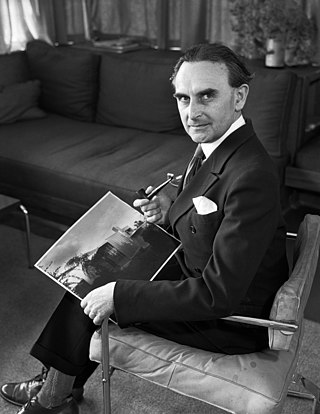
Richard Joseph Neutra was an Austrian-American architect. Living and building for most of his career in Southern California, he came to be considered a prominent and important modernist architect. His most notable works include the Kaufmann Desert House, in Palm Springs, California.

The Case Study Houses were experiments in American residential architecture sponsored by Arts & Architecture magazine, which commissioned major architects of the day, including Richard Neutra, Raphael Soriano, Craig Ellwood, Charles and Ray Eames, Pierre Koenig, Eero Saarinen, A. Quincy Jones, Edward Killingsworth, Rodney Walker, and Ralph Rapson to design and build inexpensive and efficient model homes for the United States residential housing boom caused by the end of World War II and the return of millions of soldiers.

Pierre Francis Koenig was an American architect and a Professor of Architecture at the University of Southern California. He taught at the USC School of Architecture from 1964 until his death in 2004. He was the director of the undergraduate building science program from 1980 to 2004. He lectured widely at other universities, and received more than 20 awards for his work. The architecture of Pierre Koenig was the subject of the book Pierre Koenig written by James Steele in 1998. Also in 1998, Koenig was elevated to "Distinguished Professor" after 35 years on the USC faculty. He received the USC Distinguished Alumni Award and the Gold Medal from the Los Angeles chapter of the American Institute of Architects.
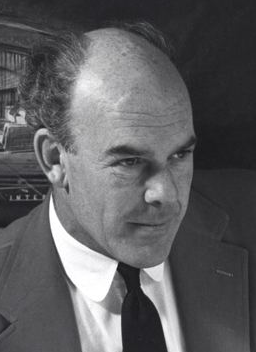
John Edward Lautner was an American architect. Following an apprenticeship in the mid-1930s with the Taliesin Fellowship led by Frank Lloyd Wright, Lautner opened his own practice in 1938, where he worked for the remainder of his career. Lautner practiced primarily in California, and the majority of his works were residential. Lautner is perhaps best remembered for his contribution to the development of the Googie style, as well as for several Atomic Age houses he designed in the late 1950s and early 1960s, which include the Leonard Malin House, Paul Sheats House, and Russ Garcia House.
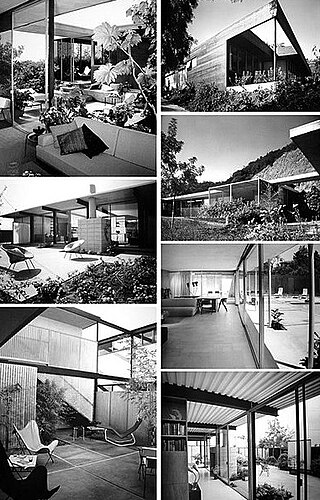
Raphael S. Soriano, FAIA, was a Greek-born American architect and educator, who helped define a period of 20th-century architecture that came to be known as Mid-century modern. He pioneered the use of modular prefabricated steel and aluminum structures in residential and commercial design and construction.

Woodbury University is a private university in Burbank, California. Founded in 1884 with initial campuses in Downtown and Central Los Angeles, Woodbury University is one of the oldest institutions of higher education in Southern California. The university consists of four schools: the School of Business, the School of Architecture, the School of Liberal Arts, and the School of Media Culture & Design.
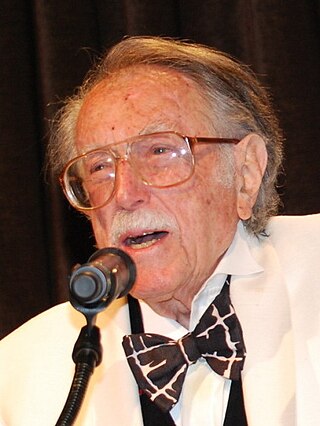
Julius Shulman was an American architectural photographer best known for his photograph "Case Study House #22, Los Angeles, 1960. Pierre Koenig, Architect." The house is also known as the Stahl House. Shulman's photography spread the aesthetic of California's Mid-century modern architecture around the world. Through his many books, exhibits and personal appearances his work ushered in a new appreciation for the movement beginning in the 1990s.
Arts & Architecture (1929–1967) was an American design, architecture, landscape, and arts magazine. It was published and edited by John Entenza from 1938–1962 and David Travers 1962–1967. Arts & Architecture played a significant role both in Los Angeles's cultural history and in the development of West Coast modernism in general. The magazine's significant cultural contributions include its sponsorship of the Case Study Houses design-build-publication program.

The Shulman House is a mid-century steel home and studio in the Hollywood Hills. In 1947 architectural photographer Julius Shulman asked architect Raphael Soriano to build him a house and studio in the Hollywood Hills. By August 1947 the design was decided upon, and construction began in the early months of 1949. The building took nine months to complete and was occupied in March 1950. Garrett Eckbo designed the landscaping. It has remained unaltered, and the Shulman House was designated a Historic-Cultural Monument by the City of Los Angeles in 1987.

The Bailey House, or Case Study House #21, is a steel-framed modernist house in the Hollywood Hills, designed by Pierre Koenig. It was registered as Los Angeles Historic-Cultural Monument #669, with the endorsement of then-owner Michael LaFetra, the Los Angeles Conservancy, and Pierre and Gloria Koenig.

Holmby Hall is an historic landmark building in Westwood Village, Los Angeles, California. Built in 1929, Holmby Hall is a streetscape of six Spanish Colonial Revival storefronts and features a prominent white clock tower, capped by a green pinnacle. The tower measures about 110 feet tall and features six levels.
Juergen Nogai is a German architecture, art and documentary photographer.
The USC School of Architecture is the architecture school at the University of Southern California. Located in Los Angeles, California, it is one of the university's twenty-two professional schools, offering both undergraduate and graduate degrees in the fields of architecture, building science, landscape architecture and heritage conservation.

James Homer Garrott Jr. (1897–1991), was an American architect active in the Los Angeles area in the mid-20th century. He designed more than 200 buildings, including twenty-five churches and several public buildings. He has been described as a "pivotal black avant garde modernist of the 1940s era."
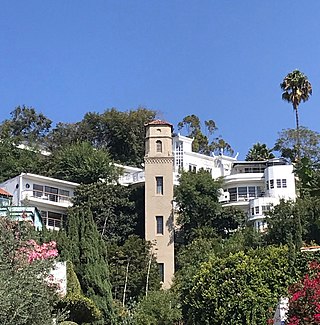
Hollywood Heights is a neighborhood in the Hollywood Hills of Los Angeles, bounded by the Hollywood Bowl on the north, Highland Avenue on the east, Outpost Estates on the west, and Franklin Avenue on the south. It includes a number of notable historic homes and buildings and has been home to numerous people in the film and music industries, dating back to the silent film era.
Soto-Michigan Jewish Community Center was a community center located at the corner of Soto Street and Michigan Avenue in the Boyle Heights section of Los Angeles, California. The building was notable for its architecture and cultural legacy, it has since closed and the building was demolished in 2006.
Julius Ralph Davidson or JR Davidson was a Mid-century modern American architect known for advancing modern architecture in Los Angeles and participating in Arts & Architecture magazine's Case Study House Program.
The Dolores Del Rio House at 757 Kingman Avenue is a house in Pacific Palisades, Los Angeles, that was designed for the Mexican actress Dolores del Río and her husband, the production designer Cedric Gibbons, by Douglas Honnold and George Vernon Russell in 1929.
The Polito House is a house in Los Angeles designed by Raphael Soriano, FAIA, built in 1938 and completed in 1940.














